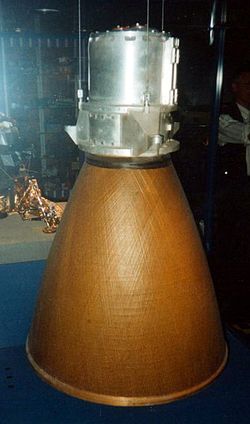Ascent Propulsion System

Apollo LM Ascent Engine
|
|
| Country of origin | United States |
|---|---|
| Date | 1964-1972 |
| Manufacturer | Bell Aircraft / Rocketdyne |
| Application | Lunar Ascent Stage/Spacecraft propulsion |
| Predecessor | Bell 8247 |
| Successor | RS-18 |
| Status | Retired |
| Liquid-fuel engine | |
| Propellant | N2O4 / Aerozine 50 |
| Cycle | Pressure-fed |
| Configuration | |
| Chamber | 1 |
| Performance | |
| Thrust (vac.) | 3,500 pounds-force (16 kN) |
| Thrust-to-weight ratio | 19.44 |
| Isp (vac.) | 311 seconds (3.05 km/s) |
| Dimensions | |
| Length | 47 inches (120 cm) |
| Diameter | 34 inches (86 cm) |
| Dry weight | 180 pounds (82 kg) |
| Used in | |
| Lunar Module as Ascent Engine | |
The Ascent Propulsion System (APS) or LMAE (Lunar Module Ascent Engine) is a fixed thrust hypergolic rocket engine developed by Bell Aerosystems for use in the Apollo Lunar Module Ascent Stage. It used Aerozine 50 fuel, and N2O4 oxidizer. Rocketdyne provided the injector system, at the request of NASA, when Bell could not solve combustion instability problems.
The LMAE traces its origin to the earlier Bell Aerosystems engines (8096, 8247) used in the RM-81 Agena, the American rocket upper stage and satellite support bus developed by Lockheed initially for the canceled WS-117L reconnaissance satellite program. The Agena served as an upper stage for several defense, intelligence, and exploration programs: SAMOS-E, SAMOS-F (ELINT Ferret) and MIDAS (Missile Defense Alarm System) military early-warning satellites, Corona photo intelligence program, and the Ranger and Lunar Orbiter lunar probes.
The Lockheed Agena target vehicle using the Bell 8247 engine was qualified for 15 restarts for NASA's Project Gemini.
A total of 365 Agena rockets were launched by NASA and the US Air Force between February 28, 1959 and the last Agena D launched on 12 February 1987, configured as the upper stage of a Titan 34B.
During the spring of 1963, Grumman hired Bell to develop the Lunar Module ascent engine, on the assumption that Bell's experience in development of the Air Force Agena engine would be transferable to the Lunar Module requirements. Grumman placed heavy emphasis upon high reliability through simplicity of design, and the ascent engine emerged as the least complicated of the three main engines in the Apollo space vehicle, including the LM descent and CSM service propulsion system engines.
...
Wikipedia
